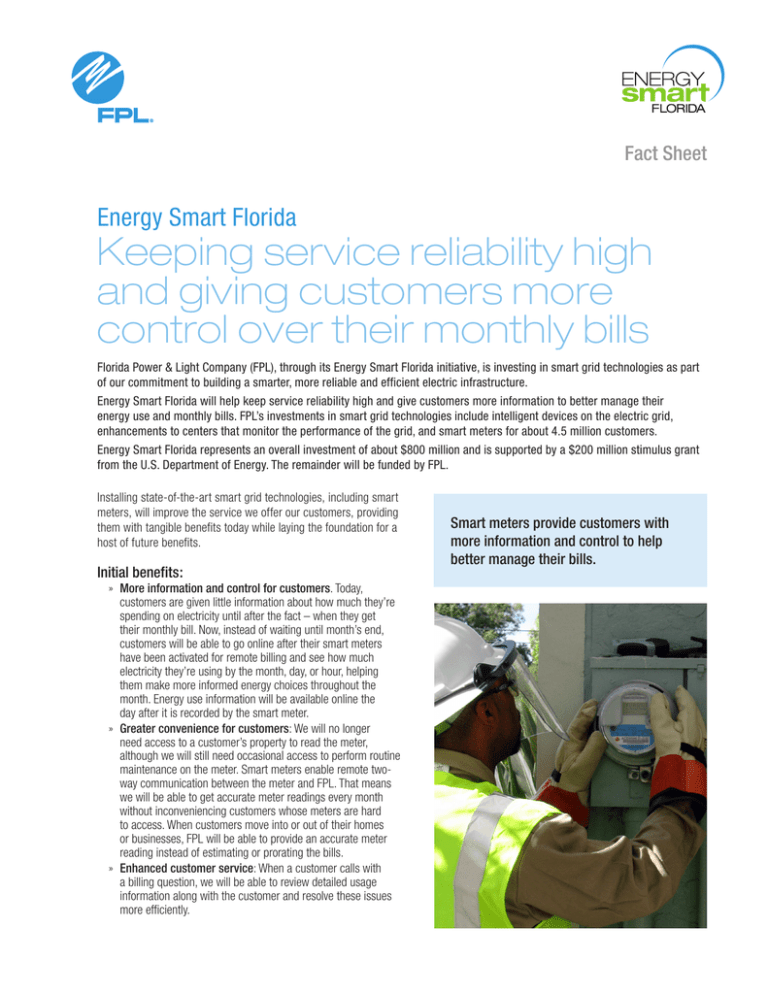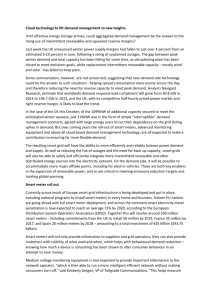Keeping service reliability high and giving customers more Energy Smart Florida
advertisement

Fact Sheet Energy Smart Florida Keeping service reliability high and giving customers more control over their monthly bills Florida Power & Light Company (FPL), through its Energy Smart Florida initiative, is investing in smart grid technologies as part of our commitment to building a smarter, more reliable and efficient electric infrastructure. Energy Smart Florida will help keep service reliability high and give customers more information to better manage their energy use and monthly bills. FPL’s investments in smart grid technologies include intelligent devices on the electric grid, enhancements to centers that monitor the performance of the grid, and smart meters for about 4.5 million customers. Energy Smart Florida represents an overall investment of about $800 million and is supported by a $200 million stimulus grant from the U.S. Department of Energy. The remainder will be funded by FPL. Installing state-of-the-art smart grid technologies, including smart meters, will improve the service we offer our customers, providing them with tangible benefits today while laying the foundation for a host of future benefits. Initial benefits: » More information and control for customers. Today, customers are given little information about how much they’re spending on electricity until after the fact – when they get their monthly bill. Now, instead of waiting until month’s end, customers will be able to go online after their smart meters have been activated for remote billing and see how much electricity they’re using by the month, day, or hour, helping them make more informed energy choices throughout the month. Energy use information will be available online the day after it is recorded by the smart meter. » Greater convenience for customers: We will no longer need access to a customer’s property to read the meter, although we will still need occasional access to perform routine maintenance on the meter. Smart meters enable remote twoway communication between the meter and FPL. That means we will be able to get accurate meter readings every month without inconveniencing customers whose meters are hard to access. When customers move into or out of their homes or businesses, FPL will be able to provide an accurate meter reading instead of estimating or prorating the bills. » Enhanced customer service: When a customer calls with a billing question, we will be able to review detailed usage information along with the customer and resolve these issues more efficiently. Smart meters provide customers with more information and control to help better manage their bills. Customers will receive these initial benefits when the transition to smart meters has been completed in their area. This can take several months after the smart meter has been installed at the customer’s premise. That’s because there are a lot of associated communications and networking components that must be put into place to enable communication. Once all of these elements are installed, FPL performs extensive tests to verify that the performance of the system meets FPL's strict criteria. In the interim, we will continue to read the meter manually. When the meter is activated, FPL will begin billing the customer based on the remote readings from the smart meter. Customers will then be able to access their detailed usage information online. Near-term benefits: FPL is using proven technologies to deliver the following benefits: » Outage prevention: Smart grid technologies will enable FPL to prevent some potential power outages before they occur. Performance and Diagnostic Centers are like “nerve centers” that gather and analyze data, enabling FPL to perform predictive maintenance before brewing issues become disruptive problems. » Outage identification: Advanced sensors and switches can help quickly identify an outage and reroute power around the trouble spot, confining the outage and preventing it from spreading to other areas. » Faster restoration: Intelligent devices throughout the power grid – from power generation to the meter – will help reduce the impact of outages and “momentaries,” or shorter outages. Advanced monitoring equipment will help communicate the location of outages for faster repair and restoration. Smart meters, an essential component of the smart grid, will work with other components on the grid to help FPL see outages in the system so we can begin restoration faster. In addition to near-term benefits, Energy Smart Florida will lay the foundation for a host of future benefits. At FPL’s Performance and Diagnostic Centers, the company uses smart grid technology to predict and prevent power outages. Future benefits: » More customer options: Smart meters will make it possible for FPL to offer future products and services that will help customers better manage their energy usage. For example, FPL is testing home energy monitors and controllers that would use information from smart meters to help customers easily manage their energy usage, as well as an optional new rate structure. » Achieving operational efficiencies: This is part of FPL commitment to keeping customer bills low over the long term. FPL has the lowest bills of all 55 utilities in Florida, and is committed to keeping them low through long-term investments such as Energy Smart Florida. The initiative will help FPL achieve cost savings through greater operational efficiencies. » Expanded use of renewable energy: Smart grid technologies will help FPL more safely, reliably and efficiently integrate “variable” renewable power, such as solar energy, into the power grid. Unlike traditional energy sources, renewable power is variable – often changing with the weather. While renewable generation can be a challenge to manage in high percentages, smart grid technologies can help optimize the integration of these resources by balancing traditional and nontraditional power generation, ensuring there’s always enough power supply to meet demand – even if the sun hides behind a cloud. Acknowledgement & Disclaimer »This material is based upon work supported by the Department of Energy under Award Number DE-OE0000211. »Disclaimer: This report was prepared as an account of work sponsored by an agency of the United States Government. Neither the United States Government nor any agency thereof, nor any of their employees, makes any warranty, express or implied, or assumes any legal liability or responsibility for the accuracy, completeness, or usefulness of any information, apparatus, product, or process disclosed, or represents that its use would not infringe privately owned rights. Reference herein to any specific commercial product, process, or service by trade name, trademark, manufacturer, or otherwise does not necessarily constitute or imply its endorsement, recommendation, or favoring by the United States Government or any agency thereof. The views and opinions of authors expressed herein do not necessarily state or reflect those of the United States Government or any agency thereof. Please recycle.1205_23580




